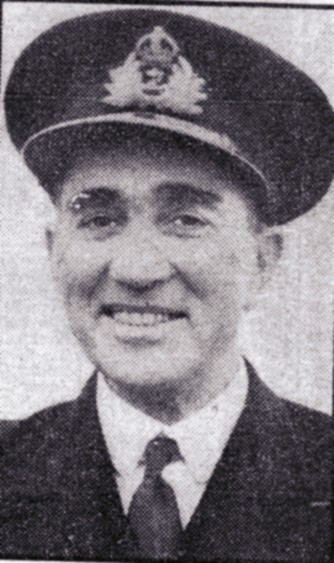Rear Admiral Arthur David TORLESSE DSO RN [1756]
- Born: 24 Jan 1902, Bognor Eng.
- Marriage (1): Sheila Mary Susan DARROCH [9872] on 29 Apr 1933
- Died: July Qtr 1995, HAM aged 93

 General Notes: General Notes:
Rear Admiral Arthur David Torlesse first joined the Navy in 1915. In the early days of the last war he was second in command of the cruiser Suffolk. In 1942 he became Assistant Director of the Naval Air Division, and was later promoted Captain and posted as Deputy Director to Naval Air Warfare (flying training). On his return from court rear he was appointed to HMS President in the Thames, for temporary duty with the Deputy Chief of Naval Staff at the Admiralty in May 1951. His home is The Cottage, Bury Road, Alverstoke, Hants.
May 14, 1952 - An expedition to test Britain's first atom bomb will set sail in about two months time. It will be headed by Rear Admiral A D Torlesse and Dr W. G. Penney, Ministry of Supply atom specialist.
This was codenamed "Hurricane" a special task force of ships left London in August 1952 for their destination on the other side of the world. The flagship was the aircraft carrier HMS Campania, which was accompanied by the landing crafts HMS Tracker and Narvik. The escort vessel was HMS Zeebrugge, and a total of 1,075 men were aboard the four vessels. But there was another ship accompanying the squadron, a battered old frigate called HMS Plym, which had been salvaged from a breaker's yard. Only a skeleton crew was on board, together with a few scientists. In the hull of Plym was Britain's greatest secret. . . . . the atomic bomb.
When the task force arrived at the Monte Bello islands, Plym was anchored near Trimoulle while the rest of the squadron withdrew to "safe" positions. Soon after Britain's "atom brain" Sir William Penney arrived by seaplane and went aboard HMS Campania where he joined the commander of the Special Squadron, Rear Admiral Arthur Torlesse.
Naval rating Albert "Nobby" Clarke was there when Penney arrived. Albert, now 68, said: "Penney went straight up to the Bridge and joined Torlesse. Refreshments were served in the wardroom while they talked.
"I remember a steward telling me that Torlesse got annoyed with Penney because he kept pinching his cigarettes.
WE had no idea who the VIP was until later, but as soon as Penney boarded there was an air of expectancy everywhere." When the time came for the bomb to go off the crew lined up on the deck with our backs to the blast. We had no protective clothing whatever. "Penney and Torlesse, of course, were safely on the bridge and facing away from the blast. When the bomb went off the ship was turned round so Penney and the rest could have a good look.
"Some scientists and ratings went ashore soon after to collect samples. But Penney and Torlesse never went near the place."
In a broadcast soon after the explosion, Penney, who travelled under the code name Mr Elmhurst, described what had happened when the bomb went off.
He said: "The sight before our eyes was terrifying, a great greyish-black cloud being hurled thousands of feet into the air and increasing in size with astonishing rapidity.
Sunday Mirror 2006.
At the start of 1945, the European war was coming to an end and in North Africa, on the old battlefield of El Alamein, General Montgomery routed the German army and finally banished them from North Africa. On 18th February 1945, after six months' training in the desert, a final exercise was held with our American allies before leaving Egypt for good to sail against Japan. The British Admiralty agreed to a request by King Farouk of Egypt to visit the Royal Navy in Alexandria. As HMS Hunter was the senior British battleship, Captain Torlesse was asked to entertain King Farouk and illustrate how an aircraft carrier operated. HMS Hunter sailed out of Alexandria Harbour and twelve Seafires from 807 Squadron showed off bombing and strafing tactics on targets towed by the escort ships. The pilots put on a great show and were entertained at the King's nightclub on the Bay in the evening. I enjoyed talking to King Faruk on the Flight Deck. The pilots each received a gold watch and the crew received crates of oranges from the King's orchards. On the following day we sailed south through the Red Sea to encounter the Japanese.
Major Clixby Fitzwilliams 2006
BDM Index Death Arthur David Torlesse Bn 24 Jan 1902. Reg Jul Qtr 1995 aged 93 Dist New Forest County Hampshire 57A 4941 35

 Other Records Other Records
1. Census: England, 2 Apr 1911, Boldre HAM. Arthur is recorded as a son aged 9 taught at home born Bognor Sussex

Arthur married Sheila Mary Susan DARROCH [9872] [MRIN: 3016], daughter of Lt.Col. Duncan DARROCH [14018] and Elizabeth BOUGHEY [14019], on 29 Apr 1933. (Sheila Mary Susan DARROCH [9872] was born in 1908.)
|




 General Notes:
General Notes: